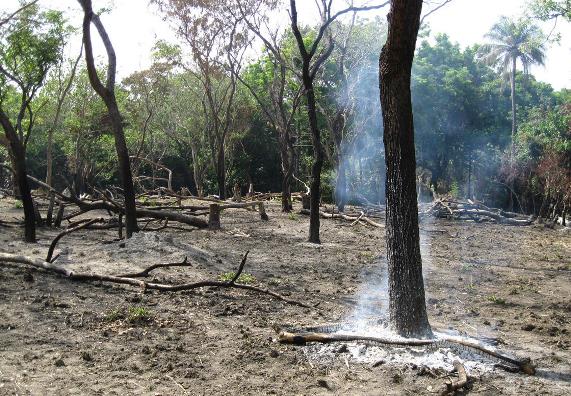Forests absorb and store carbon. If this ability is hampered, then levels of atmospheric carbon will increase and global temperatures will rise, leading to potentially drastic climatic changes. In particular, deforestation (the permanent elimination of forests in order to utilize the land for other uses) in the tropics has contributed to soaring carbon dioxide (CO2) emissions, creating an acknowledged troubling trend in modern times. However, investigators analyzing the conditions of tropical forests have revealed another source—forest degradation and disturbance—that is contributing significantly to elevations in CO2 emission levels. See also: Carbon dioxide; Climate modification; Deforestation; Forest; Forest ecosystem; Forestry; Global climate change; Global warming; Greenhouse effect; Tropical forest

Specifically, satellite imagery of the world's tropical forests—especially those in the Americas, Africa, and Asia—indicates a higher proportion of harmful carbon emissions emanating from various forms of forest degradation. Degradation, in general, includes simple reductions in the number, density, and diversity of trees in a certain area or region. These reductions in the biomass of tropical trees can occur as a result of actions that are detrimental to the health of forests, although falling short of being permanent acts of deforestation. Such forms of degradation include selective logging, small wildfires, and other limited changes to the immediate forest environment. In these cases, the forests still remain; however, they are collectively degraded, having less biomass and being less dense. Thus, overall, tropical forests are no longer acting as "carbon sinks," converting atmospheric carbon into oxygen; instead, tropical forests are becoming emitters of carbon. In fact, they are now adding two times as much carbon as they consume (862 tetragrams of carbon being emitted, as compared to 437 tetragrams being consumed). See also: Biodiversity; Biomass; Ecological communities; Forest fire; Logging; Tree
It was previously thought that degradation, although not an ideal process, still preserved the ability and capacity of tropical forests to continue to take up carbon. Therefore, in recent years, scientists and conservationists have been focused on achieving reductions in the levels of full-scale deforestation, thinking that this would allow tropical forests to continue to act as absorbers and repositories of carbon. However, the latest data indicate that more subtle forms of forest degradation are contributing heavily to the rise in CO2 levels. Researchers estimate that approximately 69% of the net carbon lost to the atmosphere is the result of tropical forest degradation, with the remainder coming from deforestation. This will have dramatic consequences for how environmentalists seek remedies to combat global climate change. Given these new estimates concerning degradation's contribution to carbon emissions, researchers will be forced to re-evaluate overall forest policies, which in the past typically focused on halting deforestation, and will need to include initiatives to limit degradation as well. Therefore, efforts that protect existing tropical forests and restore forests that have been eliminated are key steps to keeping global carbon levels in check. See also: Conservation of resources; Environmental management; Forest engineering; Land-use planning; Reforestation; Restoration ecology





